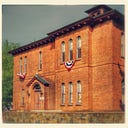“Jane Toppan is Dead”
By William F. Hanna
“Why are you here, Jane?”
“Murder, they tell me.”
“How many people did you kill?”
“Thirty-one.”
“How did you kill them?”
“Poison.”
That is how William Hale Reed, newspaper man and editor of the Taunton Daily Gazette, remembered an earlier conversation with Jane Toppan. The reminiscence was published on August 20, 1938, three days after Toppan’s death. Eighty-one years old when she died, she had spent the previous thirty-six years as a patient at the Taunton State Hospital. Obituaries don’t always tell the whole truth, so when hers stated that she had been “a quiet, unassuming little woman, content to remain peacefully at the institution,” the writer was sacrificing accuracy in the service of kindness.

Jane had quite a story to tell. She was born Honora Kelly in 1857 in Boston’s North End. She and her three sisters were the unfortunate daughters of an alcoholic known in the neighborhood as “Kelly the Crock.” Upon the death of her parents in 1863, she was brought to the Boston Female Asylum for Destitute Girls, and from there adopted by Captain and Mrs. Abner Toppan. Her new parents took her home to Lowell expecting to raise her in a stable, well-ordered Christian household.
The new arrival was an apparently happy young woman, active in the Congregational Church and its Sunday school. “Jane Toppan,” as she was now called, graduated from Lowell High School and decided to pursue a career in nursing. She first joined the staff at Cambridge Hospital, where she enjoyed an excellent reputation. Moving on to the nursing school at the Massachusetts General Hospital, she found similar success, though at the time it wasn’t widely known that she had been denied her diploma because she had left her ward one night without permission.
Jane spent the next several years nursing in the Boston area and to all outward appearances she was at the top of her profession. Only later was it learned that she had falsified her credentials in order to gain a head nurse’s position at the Cambridge hospital, and also that she had a history of conflict with some of her colleagues. Among the hundreds who knew her, however, she was indeed “the best nurse in Cambridge.”

Unmarried and approaching middle age, Jane occasionally accepted private duty nursing assignments in the homes of friends or acquaintances. During the summer of 1901 she was in Cataumet, on Cape Cod, caring for a member of the Gibbs family. Throughout that season several members of the family sickened and died, apparently of mysterious illnesses. The last victim was Mrs. Mary Gibbs, whose symptoms puzzled a local physician called in to witness her last hours. He noted that the patient breathed spasmodically, twitched nervously, had dry skin and slightly dilated pupils. These symptoms, said the doctor, bore all the signs of morphine poisoning, except the contracted pupils.
When Mrs. Gibbs died, her husband, a sea captain, called for an autopsy, but his request was denied because there seemed to be no reason to suspect foul play. Not satisfied, Capt. Gibbs began his own investigation into Jane Toppan’s background. He traveled to Cambridge, Boston and Lowell, and at every stop he was able to add pieces to the puzzle. Not only did he discover that a trail of lies and deception followed Jane; he also found that an appalling number of suspicious deaths marked her nursing career. For many a trusting soul, it seemed, Jane was an angel of death.
The evidence presented by Capt. Gibbs persuaded the authorities to conduct autopsies on the deceased members of his family. Results showed that they had indeed died of morphine poisoning. Also present were heavy doses of stropin, a chemical that prevented the victims’ pupils from dilating, and thus masking the symptoms of morphine overdose. When it was learned that Jane had recently purchased large amounts of morphine from Falmouth and Wareham drugstores using forged prescriptions, prosecutors decided to bring her nursing career to an end.
Jane was arrested on October 31, 1901, at the home of another probable victim living in Nashua, New Hampshire. Brought to the Barnstable jail, she passed the winter while the wheels of justice ground ever so slowly. Indicted on three counts of murder, she was examined by several “alienists,” as psychiatrists were known at that time. Over the course of the investigation, Jane confessed to having poisoned about 100 persons, though the official death toll stands at thirty-one. Declared insane, she was brought to the Taunton State Hospital in June 1902.
Over the next thirty-six years, “Jolly Jane,” as she was called in the press, lived a fairly quiet life, though the demons of her past occasionally caused her pain. She was occasionally troublesome and there was a period, for example, when she was not to be trusted with matches because she lit fires in bedding and clothes hampers. Toward the end of her life she often refused to eat, certain that one of her victims had poisoned her food in order to exact revenge.
Jane died on August 19, 1938 and was buried two days later at the Mayflower Hill Free Ground, known to Tauntonians simply as “paupers field.” Her final rites were unannounced and unattended, and there she lies to this day.

Upon her death and remembering the long-ago interview with Jane, Editor Reed wrote: “Such things make an impression upon newspaper men, hardened though they may get to many of the sadder things in the world. . . .”
